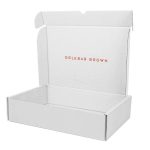In the fast-paced world of automotive manufacturing and repair, attention often gravitates toward shiny engines, advanced technology, and sleek designs. Yet, hidden in plain sight lies a critical component that ensures everything runs smoothly: the auto parts packaging box. More than just a container, these specialized boxes serve as guardians of precision, quality, and efficiency. From protecting delicate components during transit to streamlining inventory management, auto parts packaging boxes are the unsung heroes driving the automotive industry forward.
Why does packaging matter so much? Consider the journey of an automotive part—from manufacturer to distributor, then to a repair shop or end-user. Each step presents risks: vibrations during shipping, temperature fluctuations, moisture exposure, and potential impacts. A standard cardboard box simply won’t suffice for sensitive components like electronic sensors, brake pads, or fuel injectors. Auto parts packaging boxes are engineered with durability in mind, often incorporating reinforced edges, custom-fit inserts, and moisture-resistant materials. This meticulous design prevents damage, reduces returns, and ultimately saves time and money for businesses and consumers alike.
Beyond protection, these boxes play a pivotal role in branding and customer experience. Imagine unboxing a premium car part housed in a flimsy, generic container—it undermines the product’s value. Conversely, a well-designed auto parts packaging box with clear labeling, intuitive handling instructions, and the manufacturer’s logo reinforces trust and professionalism. For companies, this is an opportunity to differentiate themselves in a competitive market. Custom-printed boxes not only enhance brand recognition but also communicate a commitment to quality, influencing purchasing decisions and fostering customer loyalty.
Innovation in auto parts packaging has also embraced sustainability. As environmental concerns grow, manufacturers are shifting toward eco-friendly materials like recycled corrugated cardboard, biodegradable plastics, and minimalist designs that reduce waste. Lightweight yet robust packaging lowers shipping costs and carbon footprints, aligning with global sustainability goals. For instance, some companies now use modular packaging systems that can be reused or repurposed, creating a circular economy within the automotive supply chain. This green revolution isn’t just a trend—it’s a strategic move that resonates with eco-conscious consumers and regulatory standards.
Efficiency is another cornerstone of modern auto parts packaging. Warehouses and repair shops handle thousands of components daily, and disorganized packaging can lead to chaos. Standardized box sizes, color-coded labels, and QR codes for inventory tracking simplify logistics and reduce errors. Smart packaging solutions even integrate with digital systems, allowing technicians to scan a code and instantly access installation guides or warranty information. This seamless integration between physical packaging and digital tools enhances productivity, minimizes downtime, and ensures that the right part reaches the right place at the right time.
Looking ahead, the future of auto parts packaging is poised for further transformation. Technologies like IoT-enabled smart packaging—which monitors temperature, humidity, and shocks in real-time—are already on the horizon. 3D-printed custom inserts could offer hyper-personalized protection for unique components, while AI-driven design software might optimize box structures for maximum strength and minimal material use. As electric and autonomous vehicles redefine the automotive landscape, packaging will adapt to safeguard advanced electronics and battery systems. The humble auto parts packaging box, once an afterthought, is now at the forefront of innovation.
In conclusion, auto parts packaging boxes are far more than mere containers. They are strategic assets that ensure safety, enhance branding, promote sustainability, and drive operational efficiency. Whether you’re a manufacturer, distributor, or end-user, recognizing the value of high-quality packaging can lead to tangible benefits. So, the next time you receive an auto part, take a moment to appreciate the box it came in—it’s a testament to the meticulous engineering and forward-thinking that keeps the automotive world moving.




Leave a Message